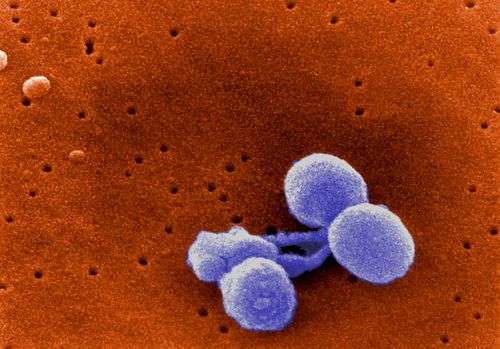Streptococcus pneumoniae: Meningitis: Difference between revisions
Slonczewski (talk | contribs) No edit summary |
SullivanMark (talk | contribs) No edit summary |
||
| Line 15: | Line 15: | ||
<br><b>Superscript:</b> Fe<sup>3+</sup> | <br><b>Superscript:</b> Fe<sup>3+</sup> | ||
<br><i>Streptococcus | <br><i>Streptococcus pneumoniae</i> is a non-motile, non-spore forming, gram-positive bacteria of the firmicute phylum. <i>S. pneumoniae</i> is also commonly referred to as pneumococcus [1,2]. <i>Streptococcus pneumoniae</i> are in the shape of a slightly pointed coccus. The diameter of each single pneumococcus organism ranges from 0.5 to 1.25 micrometers. <i>S. pneumoniae</i> is found singly and in short chains, but mainly these bacteria are found in pairs (diplococci) [2]. <i>Streptococcus pneumoniae</i> uses fermentation to produce energy via converting glucose into lactic acid. Furthermore, <i>Streptococcus pneumoniae</i> utilizes extracellular enzyme systems in order to obtain carbon and nitrogen, and these processes damage host tissue and permit <i>S. pneumoniae</i> to colonize the host (Todar 2003). <i>Streptococcus pneumoniae</i> and Haemophilus influenzae contribute to the same mucosal microenvironment. Both bacteria are capable of living on their own. But, Lysenko et al. (2005) showed that Haemophilus influenzae swiftly outcompetes <i>Streptococcus pneumoniae</i> when they are in the same environment. Thus, H. influenzae can remove populations of the <i>S. pneumoniae</i> pathogen (Lysenko et al. 2005).<br> | ||
<br>This bacteria exclusively inhabits human beings and are mesophillic, meaning they optimally inhabit areas with temperatures ranging from 30 to 35 degrees Celsius. <i>Streptococcus pneumoniae</i> is most commonly found in the upper respiratory tract, specifically in the nasopharynx (the nasal passages). Most people carry these bacteria in their nasopharynx, and the harboring of <i>S. pneumoniae</i> within a human is called carriage. Even though most people carry these bacteria in their nasopharynx, most of the time <i>S. pneumoniae</i> does not cause disease [1,2].<br> | |||
<br>A polysaccharide capsule encloses the entire <i>S. pneumoniae</i> cell, and this sugar capsule is key to this bacteria’s virulence. There are hundreds of surface proteins on <i>Streptococcus pneumoniae</i>. Choline-binding proteins are an important group of surface proteins expressed by <i>S. pneumoniae</i>, and this group of proteins helps attach the bacteria to human cells (Todar 2003).<br> | |||
Revision as of 05:42, 24 April 2011
Introduction
At right is a sample image insertion. It works for any image uploaded anywhere to MicrobeWiki. The insertion code consists of:
Double brackets: [[
Filename: PHIL_1181_lores.jpg
Thumbnail status: |thumb|
Pixel size: |300px|
Placement on page: |right|
Legend/credit: Electron micrograph of the Ebola Zaire virus. This was the first photo ever taken of the virus, on 10/13/1976. By Dr. F.A. Murphy, now at U.C. Davis, then at the CDC.
Closed double brackets: ]]
Other examples:
Bold
Italic
Subscript: H2O
Superscript: Fe3+
Streptococcus pneumoniae is a non-motile, non-spore forming, gram-positive bacteria of the firmicute phylum. S. pneumoniae is also commonly referred to as pneumococcus [1,2]. Streptococcus pneumoniae are in the shape of a slightly pointed coccus. The diameter of each single pneumococcus organism ranges from 0.5 to 1.25 micrometers. S. pneumoniae is found singly and in short chains, but mainly these bacteria are found in pairs (diplococci) [2]. Streptococcus pneumoniae uses fermentation to produce energy via converting glucose into lactic acid. Furthermore, Streptococcus pneumoniae utilizes extracellular enzyme systems in order to obtain carbon and nitrogen, and these processes damage host tissue and permit S. pneumoniae to colonize the host (Todar 2003). Streptococcus pneumoniae and Haemophilus influenzae contribute to the same mucosal microenvironment. Both bacteria are capable of living on their own. But, Lysenko et al. (2005) showed that Haemophilus influenzae swiftly outcompetes Streptococcus pneumoniae when they are in the same environment. Thus, H. influenzae can remove populations of the S. pneumoniae pathogen (Lysenko et al. 2005).
This bacteria exclusively inhabits human beings and are mesophillic, meaning they optimally inhabit areas with temperatures ranging from 30 to 35 degrees Celsius. Streptococcus pneumoniae is most commonly found in the upper respiratory tract, specifically in the nasopharynx (the nasal passages). Most people carry these bacteria in their nasopharynx, and the harboring of S. pneumoniae within a human is called carriage. Even though most people carry these bacteria in their nasopharynx, most of the time S. pneumoniae does not cause disease [1,2].
A polysaccharide capsule encloses the entire S. pneumoniae cell, and this sugar capsule is key to this bacteria’s virulence. There are hundreds of surface proteins on Streptococcus pneumoniae. Choline-binding proteins are an important group of surface proteins expressed by S. pneumoniae, and this group of proteins helps attach the bacteria to human cells (Todar 2003).
Section 1
Include some current research in each topic, with at least one figure showing data.
Section 2
Include some current research in each topic, with at least one figure showing data.
Section 3
Include some current research in each topic, with at least one figure showing data.
Conclusion
Overall paper length should be 3,000 words, with at least 3 figures.
References
Edited by student of Joan Slonczewski for BIOL 238 Microbiology, 2011, Kenyon College.

